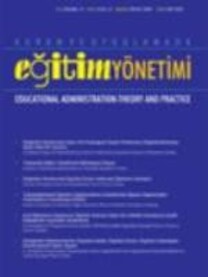Aday Öğretmenlerin Uygulamalı Eğitim Sürecinin Akran Danışma ve Kliniksel Denetim Yoluyla Desteklenmesi
Promoting Practical Training Process of Novice Teachers through Peer Consultation and Clinical Supervision
___
- Acheson, K. A., & Meredith, D. G. (2003). Clinical supervision and teacher development: Pre-service and in-service applications (5th ed.). New York: John Wiley and Sons.
- Ağaoğlu, E. (1997). Eğitimde klinik denetim. Eskişehir: Anadolu Üniversitesi.
- Aksu, M. B., Apaydın, Ç., & Kasalak, G. (2014). Novice teachers self-efficacy belief: A study of scale development. International Online Journal of Education and Teaching. 1(4), 1-16 (online). Retrieved from http://iojet.org
- Baron, W. (2006). Confronting the challenging working conditions of new teacher: What mentors and induction program can do. Mentors in the Making: Developing New Leaders for New Teachers. New York: Teacher College Press. Retrieved from http://books.google.com.tr
- Benshoff, J. M. (2001). Peer consultation as a form of supervision. Reading for Child and Youth Care Workers, 31. Retrieved from http://www.cyc-net.org
- Biss, J. L., & DuFrene, D. (2006). An examination of reverse mentoring in the workplace. Business Education Digest, 15, 30-41.
- Creswell, J. W., & Vicki. L. P. C. (2011). Designing and conducting mixed methods research. Thousand Oaks, CA: Sage.
- Cruz, M. J. de la T., & Pedro F. C. A. (2007). Comparative analysis of expectancies of efficacy in in-service and prospective teachers. Teaching and Teacher Education, 23(5), 641-652.
- Eurydice. (2007). Retrieved from http://www.eurydice.org
- Glickman, C.D., Gordon, S. P., & Ross-Gordon, J. M. (2010). Supervision and instructional leadership: A developmental approach (9th ed.). Boston: Pearson Education.
- Goldhammer, R., Anderson, R. H., & Krajewski, R. J. (1980). Clinical supervision: Special methods for the supervision of teachers (2nd ed.). New York: Holt, Rinehart and Winston.
- Gürsoy, E., Bulunuz, N., Göktalay, Ş. B., Bulunuz, M., Kesner, J., & Salihoğlu, U. (2013). Clinical supervision model to improve supervisory skills of cooperating teachers and university supervisors during teaching practice. Hacettepe University. Journal of Education (Special Issue: 1), 191-203.
- Hampton, W. L. (2009). Clinical supervision: A case study of clinical supervision as it relates to the improvement of novice teachers (Unpublished master thesis). Retrieved from ProQuest Dissertations and Thesis database. (UMI No. 1466122)
- Heppner, P. P., & Johnston, J. A. (1994). Peer consultation: Faculty and students working together to improve teaching. Journal of Counseling and Development, 72(5), 492-499.
- Herlihy, B., Gray, N., & McCollum, V. (2002). Legal and ethical issues in school counselor supervision. Professional School Counseling, 6(1), 55.
- Karasar, N. (2008). Bilimsel araştırma yöntemi. (18. baskı). Ankara: Nobel.
- MEB (2014). Millî eğitim temel kanunu ile bazı kanun ve kanun hükmünde kararnamelerde değişiklik yapılmasına dair kanun. http://www.resmigazete.gov.tr adresinden indirilmiştir.
- MEB (1995). Milli eğitim bakanlığı aday memurlarının yetiştirilmesine ilişkin yönetmelik. http://mevzuat.meb.gov.tr adresinden indirilmiştir.
- Paker, T. (1995). Clinical supervision as in-service teacher development. Çukurova Üniversitesi Eğitim Fakültesi Dergisi, 1(11), 39-53.
- Romi, S., & Leyser, Y. (2006). Exploring inclusion pre-service training needs: A study of variables associated with attitudes and self-efficacy beliefs. European Journal of Special Needs Education, 21(1), 85-105.
- Ozder, H. (2011). Self-efficacy beliefs of novice teachers and their performance in the classroom. Australian Journal of Teacher Education, 36(5) (online). Retrieved from http://dx.doi.org/10.14221/ajte.2011v36n5.1
- Schermelleh-Engel, K., Moosbrugger, H., & Müller, H. (2003). Evaluating the fit of structural equation models: Tests of significance and descriptive goodness of fit measures. Methods of Psychological Research Online, 8(2), 23-74. Retrieved from http://www.mpr-online.de
- Schumacher, G., Grigsby, B., & Vesey, W. (2015). Determining effective teaching behaviors through the hiring process. International Journal of Educational http://dx.doi.org/10.1108/IJEM-04-2013-0071 29(1), 139-155. Retrieved from
- Sergiovanni, T. J. (1977). Handbook for department leadership: Concepts and practices in today's secondary schools. Boston: Allyn and Bacon.
- Sergiovanni, T. J., & Starratt, R. J. (2002). Supervision: A redefinition (7th ed.). New York: McGraw-Hill.
- Stephens, M., & Moskowitz, J. (1997). Teacher induction policy and practice among APEC members: Results of the exploratory survey. Retrieved from http://www.ed.gov/pubs/APEC/ch2.htm
- Stronge, J. H. (2002). Qualities of effective teachers. Alexandria, VA: Association for Supervision and Curriculum Development.
- Ware, H., & Kitsantas, A. (2007). Teacher and collective efficacy beliefs as predictors of professional commitment. The Journal of Educational Research, 100(5), 303-310.
- Wertheim, C., & Leyser, Y. (2002). Efficacy beliefs, background variables, and differentiated instruction of Israeli prospective teachers. Journal of Educational Research, 96(1), 54-63.
- Woolfolk, A.E., Rosoff, B., & Hoy, W.K. (1990). Teachers' sense of efficacy and their beliefs about managing students. Teaching and Teacher Education, 6(2), 137-148.
- ISSN: 1300-4832
- Yayın Aralığı: 4
- Başlangıç: 1995
- Yayıncı: Pegem Akademi Yayıncılık Eğitim Danışmanlık Hizmetleri Tic. Ltd. Şti.
Mualla Bilgin AKSU, Türkan AKSU, Çiğdem APAYDIN, GAMZE KASALAK, Oya TAN, YEŞİM ŞENOL
Lise Öğrencilerinin Demokratik Okul Kültürü Algılarının İncelenmesi
KÜBRA ATALAY KABASAKAL, Sakine Göçer ŞAHİN, HÜLYA KELECİOĞLU, SELAHATTİN GELBAL, BURCU ATAR, NURİ DOĞAN
Öğretmenlerin Okulda Karşılaştıkları Mobbinge İlişkin Hizmet Süresinin Etkisi: Bir Meta-Analiz
Serbest Kıyafet Uygulaması: Kim Ne Söyledi?
CELAL TEYYAR UĞURLU, SONER DOĞAN, İhsan TOPÇU, Ahsen DEMİR
Etik İklim ile Öğretmen ve Öğrencilerin Güven ve Motivasyon Düzeyleri Arasındaki İlişki
